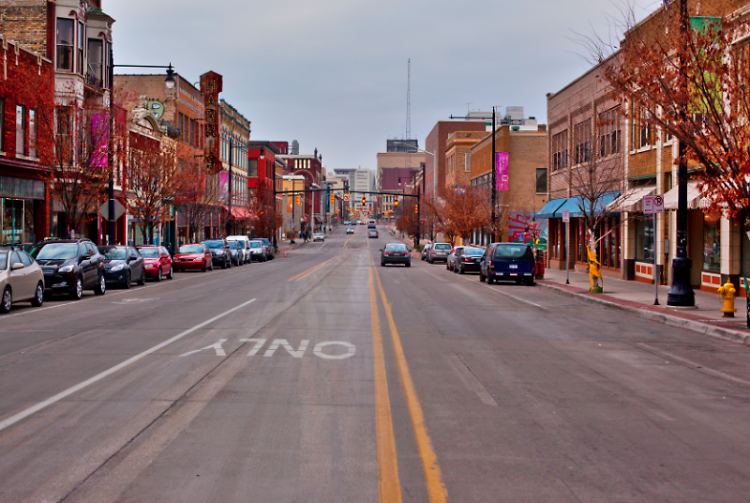Anyone who spends time in downtown Grand Rapids can see obvious signs of economic resurgence, especially in the area around Monroe Center. However, looking south from Fulton Street toward the Heartside Neighborhood, the economic picture is more mixed. There is some new construction and some conversion of older properties in Heartside. South Division is now home to trendy shops and galleries. Ionia Street is one of city’s hottest locales for new, upscale restaurants and bars. It is also clear that a segment of the Heartside population has been left behind as the local economy rebounds.
To get a better sense of the changes in the Heartside neighborhood, Joel Stillerman, PhD, an urban sociologist and GVSU professor, took a walk around South Division Avenue and talked about the causes of the rise in homelessness.
“It is pretty widely accepted among urbanists that one of the key drivers of homelessness is the mismatch between average wages and average housing prices. The National Low Income Housing Coalition publishes this data analysis every year called ‘Out of Reach’ in which they show what the minimum wage would need to be in order for people to be able to afford average rentals across the country and that average is about $18.00 an hour,” he says.
Stillerman believes that homelessness is a systemic national problem, but also praises local agencies such as LINC, Dwelling Place, Habitat for Humanity and Well House for taking a holistic approach to homelessness and for finding transitional and permanent housing for homeless and low-income individuals.
“The issue is that the problem is so much bigger than an individual organization can attack," he says. "The problem of homelessness is a systemic one and in Grand Rapids it’s pretty mild compared to larger cities with much more expensive housing.”
Walking around Heartside, Stillerman points out the new construction, upscale businesses and galleries- all evidence of ongoing gentrification of the neighborhood.
Artists and galleries have been a presence in Heartside at least since the early 2000’s. The influx of artists was bolstered by a Cool Cities grant in 2004. Stillerman was around when the Cool Cities Initiative was first proposed. He had his doubts about the idea.
“People who were involved in this work really thought that you could promote the arts in the neighborhood and not have a negative impact on the homeless population that’s taking advantage of shelters and other services. I was quite skeptical about that and I have to say that, unfortunately, I think I was right,” he says. “Artists themselves may not be affluent but their presence makes a neighborhood more attractive to other people who are."
In the typical gentrification cycle, a long neglected neighborhood becomes chic, and therefore more expensive. Poor residents are forced out. In many cases, artists are eventually priced out of the very neighborhoods that their presence made fashionable.
Steven Vinson, an artist who rents living space, studio space and Spiral, an art exhibition space located at 44 S. Division., worries that he could eventually be priced out of the neighborhood.
“The thing I would miss most about the Heartside neighborhood would be the diversity of the people I see on a daily basis,” he says. “Personally I do not worry about being the villain as an artist in a potential gentrification area. It will always be the people that are controlling pricing that are the villains in that situation. I do understand that artists are usually the seeds of gentrification but artists are respectful of their spaces, the community and to one another. The problem will always be the people that view the artist(s) as a tool to drive up property value.”
Stillerman predicts more affluent residents moving in to Heartside in the next five to 10 years.
“I don’t know how many or what percentage of the residential population it will be. You’ll see more affluent people patronizing the restaurants and galleries as well," says Stillerman. But, he says, "I don’t foresee the elimination of all the services for the homeless people here.”
“My guess is that the homeless population will continue to be here," he says. "Although there will be increasing discomforts probably from both sides.”
The Rapidian, a program of the 501(c)3 nonprofit Community Media Center, relies on the community’s support to help cover the cost of training reporters and publishing content.
We need your help.
If each of our readers and content creators who values this community platform help support its creation and maintenance, The Rapidian can continue to educate and facilitate a conversation around issues for years to come.
Please support The Rapidian and make a contribution today.
